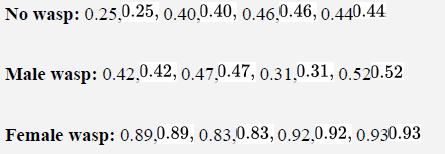The parasitoid wasp, Leptopilina heterotoma, injects eggs into young larvae of fruit flies, Drosophila melanogaster. One reaction
Question:
The parasitoid wasp, Leptopilina heterotoma, injects eggs into young larvae of fruit flies, Drosophila melanogaster. One reaction by the flies is to self-medicate by consuming alcohol (ethanol), which is naturally present in the decaying fruits where they live. The ethanol reduces oviposition by wasps, and it increases death rates of wasp larvae within parasitized flies. Kacsoh et al. (2013) investigated whether the presence of the wasp influences where female fruit flies prefer to lay their eggs. They presented female flies in cages with two dishes of fly food, one having 6% ethanol and the other with 0% ethanol. They recorded the proportion of eggs laid in the 6% ethanol dish when females were placed with female wasps, with male wasps, or with no wasps. The data below give the proportion of eggs laid in the ethanol dish for multiple replicates of each wasp treatment.

a. Proportion data often show differences in standard deviations between groups that differ in the mean proportion (tending to be smaller in groups whose means are close to 0 or 1). Do these data show such a trend? To answer, make a table of the means and standard deviations of groups (include sample sizes).
b. Carry out a transformation suitable for proportion data and then make a new table. Does the transformation reduce heterogeneity among groups in the standard deviation?
c. Test the null hypothesis of no differences among group means using the transformed data.
d. What fraction of the variation in the response variable is explained by treatment?
Step by Step Answer:

The Analysis Of Biological Data
ISBN: 9781319226237
3rd Edition
Authors: Michael C. Whitlock, Dolph Schluter





